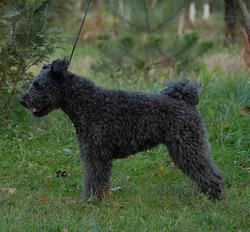 |
| Gr Ch Blue Grass Undis Ultravox |
General Appearance:
The Pumi is a cheerful, medium sized herding dog of Terrier type. His Terrier character is most obvious in his head. The foreface is elongated and the upper third of the otherwise prick ears is bending forward. The conformation is square. Because of his constant alertness, his neck carriage is higher than normal. The wavy coat of medium length forms curls. The Pumi can have various colours but must always be of one solid colour.
Most Pumis are grey, and any shade of grey is accepted in the show ring. Grey Pumis are born black but puppies usually start greying at the age of 6 to 8 weeks, and the shade gradually lightens. The final shade can be predicted by the color of the parents.
The coat is curly, thick, and of medium length, approximately 7 cm long and consisting of a harsh topcoat and soft undercoat. The coat is maintained by combing every few weeks, and trimming every 2 to 4 months. The coat grows constantly (similar to that of the Poodle) and, if grooming is not maintained, the coat may start matting. This breed has little to no shedding. The Pumi trademark is its ears, which are always alert and very lively. Ears are high-set and the tip bends down. Ears are covered with longer hair than the rest of the body. The Pumi is a light-bodied, square dog that looks slightly larger than it is because of the thick coat. The Pumi has a long, narrow head. The muzzle is 45% of the length of the head, which is of equal length to the neck. The stop is barely noticeable, and the skull is flat when seen from the side. The eyes are small, dark, and slightly oblique. Movements are lively and energetic, as is the Pumi itself. Male Pumis stand 41 to 47 cm at the withers and weigh 10 to 15 kg; bitches are 38 to 44cm and weigh 8 to 13 kg.
Characteristics:
The Pumi is a herding dog of Terrier type. Also suitable for herding larger types of animals. His scenting ability is well developed. Has excellently proved his worth when combating wild beasts of prey or rodents. Excellent house pet and can definitely be kept indoors. Needs plenty of exercise. Is an excellent companion and sporting dog.
Temperament:
This rather lively herding dog has a restless temperament. Extremely bold, a little suspicious towards strangers. As a result of his sensible behaviour, his liveliness and his expressiveness, he attracts attention always and everywhere. The Pumi is rather noisy. His whole appearance embodies thirst for action and because of his restlessness and activity, all parts of his body are constantly on the move. He is always active and ready for duty. A shy or phlegmatic behaviour are untypical of the breed. The Pumi can be very protective of its own family, and often slightly reserved toward strangers, so socialization must begin early. The Pumi is a lively and active breed. It is intelligent but barks easily. Pumik are moderately easy to train, as it is easy to motivate using toys or food. Health
Pumis are a healthy breed with a life expectancy of 12 to 14 years, but Pumis have been known to live up to 19 years. Known medical problems are patella luxation and canine hip dysplasia. The most extensive health records of the breed can be found from Finland and Sweden, and around 80% of the Pumik born there have healthy hips. |